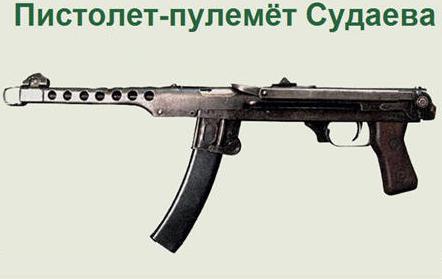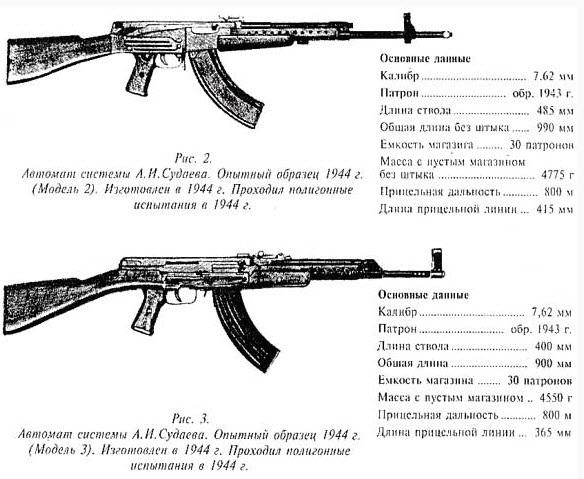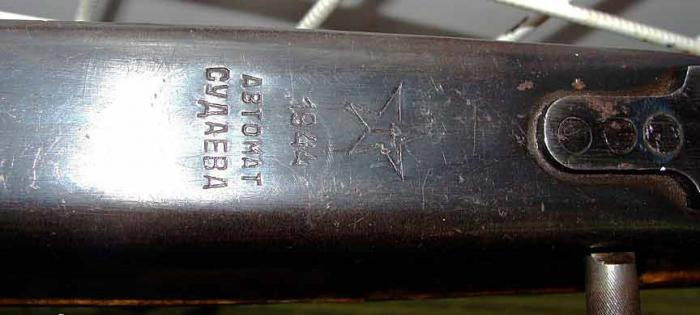Today it’s even funny to find out who was the first to create such a type of small arms as a machine gun. Mankind has been moving towards this invention purposefully. First, quick-firing submachine gun monsters appeared, then compact submachine guns were designed in different countries, and only then, by the end of World War II, a new class of weapons became known as the assault rifle, later called the assault rifle. Contemporaries interested in military-technical history know the names of the most famous designers of the era, immortalized in the name of their deadly offspring. Thompson, Schmeiser, Shpagin, Degtyarev, Kalashnikov. Sudaev's AS-44 assault rifle looks similar to both AK and StG-44, which provided food for thought that the design was supposedly taken from the Germans by one of our designers, and then, in turn, another one copied it. Especially those who insist on little technical knowledge insist on such a version, but who are inclined to worship all Western things.

Who is Sudaev
Alexey Ivanovich was born in 1912, in Alatyr (Simbirsk province). From the age of fifteen he locksmith, then he studied at a technical school, after which he worked on transport construction. He started inventing since 1933, while his first projects were somewhat fantastic (for his time), in particular, they were offered to use infrared rays for automatic control of machine gun shooting. While serving in the army, Sudaev seriously became interested in weapons. Then there was the institute in Gorky, the first creative successes, the Dzerzhinsky Academy. The defense of the thesis was in German, the cadet learned the language of a likely opponent between classes on the main course. The theme is the project of a light machine gun.
The 3rd-rank military engineer A. I. Sudaev was instructed to simplify the anti-aircraft installation, and he coped with the task, eliminating many details that turned out to be superfluous, this work was very useful in the dramatic months of the initial stage of the war. But the most significant merit of the designer was the PPS-43 submachine gun. He deserves a separate section, and about Alexei Ivanovich it is known that he was a very modest person, he didn’t even like to take pictures, only pictures for documents were preserved, and they are not of the best quality.
During his short 34-year life, this talented engineer has achieved a lot. One of his masterpieces was the AC-44. Sudaev’s assault rifle was ahead of its time in many respects, but, unfortunately, the author didn’t manage to “finish it”.
Stunning PPS-43
In fact, the concepts of “submachine gun” and “automatic” are very arbitrary. In fiction, and sometimes popular technical literature, these terms are rarely shared. Authors most often “arm” German and Soviet soldiers with machine guns, although the P-40 and PPSh are classic submachine guns. The difference is in the format of the ammunition. During almost the entire war, the Wehrmacht and the Red Army were armed with automatic samples designed for the use of a short pistol cartridge. This made it possible to carry a lighter ammunition, which is very important for the infantryman. The debate about which of the submachine guns (or machine guns, if you like) was the best, MP-40 or PPSh, did not subside for a long time.

And the answer to this question, according to many experts, is completely unexpected. The best in the war was the A. I. Sudaev assault rifle - the PPS-43 submachine gun. It was the lightest, most reliable, compact; it was they who were armed with the marines, paratroopers, front-line reconnaissance and tank crews. It was a real masterpiece, which in fact was copied after the war in many countries both officially (under license) and in a pirated way.
The emergence of a new class of small arms
PPS-43 - Sudaev's assault rifle of 1943. AS-44 was proposed to the army, as can be seen from its index, after about a few months, and this model was fundamentally different from the previous model. Firstly, it is designed for the so-called intermediate cartridge of 7.62 mm caliber, smaller in size than a rifle, but much superior in power to a pistol. Secondly, his design was completely different. Actually, the question of architecture was really revised by the German Hugo Schmeiser, who first formulated the concept of “rapid-fire assault rifle” in 1944. It was a sample of the StG-44, which was a cross between a machine gun and a submachine gun. The Sudaev AS-44 assault rifle resembles it in shape, and there are reasons for this.
About deceitful appearance
Many technical samples are similar to each other. Modern cars, for example, can be difficult to distinguish, and fighter planes too. The appearance is dictated by technical requirements, designers are pragmatic about design issues, choosing the most rational option. The AS-44 assault rifle, designed by A. I. Sudaev, resembles the “Schmeiser” and AK-47, firstly, with a curved horn of the store, secondly, with a pistol grip, and thirdly, a high front sight. However, it is enough just to open the receiver cover, and the complete uniqueness of the internal mechanism will become apparent. But first things first.
Score
The first thing that causes associations with other samples in the eyes of an uninitiated observer is the shape of the horn.
There are not so many options for the location of cartridges in the store. The disc is convenient and compact, but the weapon becomes voluminous, and it is not so convenient to carry. The edge of the store rests on the back, with long marches this contributes to the fatigue of the fighter. A direct outline (like the German MP-40) is possible, but only when pistol cartridges containing geometry close to cylindrical are in it. And the StG-44, and the AK-47, and the Sudaev AS-44 assault rifle are equipped (in the main version) with a curved arc-shaped horn. This is due to the conical (in rough approximation) form of the intermediate cartridge. There is nothing strange in this decision, only expediency. By the way, the priority of the invention of a two-row box-shaped store curved by an arc, in the vernacular “horn”, belongs not to the German Hugo Schmeiser, as is generally accepted, but to the Russian mechanic-gunsmith Fedorov. The patent is dated 1916. This, by the way, is for the advocates of the theory of "Western technical genius."

Handle
Fashion is a capricious lady; she touches on the most diverse, sometimes unexpected spheres of human activity. If the Soviet gunner-gunner, armed with PPSh, fired, "aiming the gun," the Wehrmacht soldier held his MP-40 with his right hand like a gun. By and large, it did not matter much, but the new generation of samples for the most part provided for just such a structure of the overall layout. The automatic machine of Sudaev arr. 1944. The close location of the store with the handle is dictated by the requirements of maintaining the center of mass balance.
Front sight and sight
Yes, the fly is tall, like the StG-44. This shape of the sighting unit is set by the upper location of the vent pipe. The barrel is located below, the aiming plate is fixed in the back of the box lid, and if the front sight is small, it will “fall out” of the arrow’s field of vision. At the same time, the lack of alignment of the buttstock and the barrel channel proposed by Sudaev became an original solution. As a result, the return decreased, and the accuracy increased. According to these indicators, the AU is superior to the vaunted German Schmeiser.
The similarity of silhouettes, in general, can serve as an argument only for those who are not familiar with the specifics of weapons design, and in particular with manufacturing techniques. Finding a scheme whose implementation in mass production will be problem-free, and even such that, as a result, quality and performance characteristics remain high, is the main task of a modern engineer. Creating simple and good is always much more difficult than creating a separate, albeit perfect, but complex model.
Comparison of speakers and AK
The priority of weapons technology is generally a difficult issue. The use of other people's ideas in this specific area of activity is not considered something shameful. Each weapon model, to one degree or another, is the result of a compilation of the most successful nodes and mechanisms that have been used previously.
Without questioning the merits of Mikhail Timofeevich Kalashnikov, who created the most massive machine gun in the history of mankind, it should be noted, however, that he borrowed some technical solutions from Alexei Ivanovich Sudaev. In a most general sense, the AC-44 is the forerunner of the AK-47. You can start with the very principle of using the power of powder gases to create the conditions for the next shot. At the same time, the fixed fastening of the gas piston to the bolt frame was used as early as 1927 by the designer Degtyarev when designing his machine gun. "Kalash" and "Sudaev" have one more common technological feature, in both samples the manufacture of the receiver is made by stamping. Perhaps if the AC designer had lived longer, he would have thought of other ways to simplify the technology, during the war he personally monitored the process of assembling the teaching staff and repeatedly made suggestions for improvement. But fate was so pleased that it was MT Kalashnikov who was able to bring his brainchild to that elegant simplicity, thanks to which it became one of the symbols of the era.

Features and hard choices
With the appropriate constructive tuning, Sudaev's AS-44 assault rifle could become the main model of the Soviet Army, but the author’s premature death in 1946 did not allow his creative plans to come true. In 1944, a series of tests of two variants of the specimen were passed, which revealed individual flaws (mainly low reliability of the striker and the ejector) to be eliminated. The mass of the machine in various versions was approximately 5.5 kg. The store's capacity was 30 rounds, the range of aimed fire - up to eight hundred meters. The AS-44 never entered service, sharing the fate of many other projects, including Rukavishnikov, Bulkin, Korobov, Dementiev machine guns. What to do, there were many designers, but I had to choose only one sample.